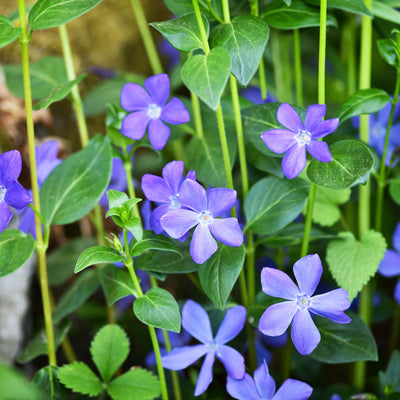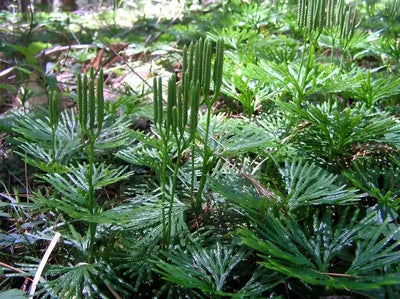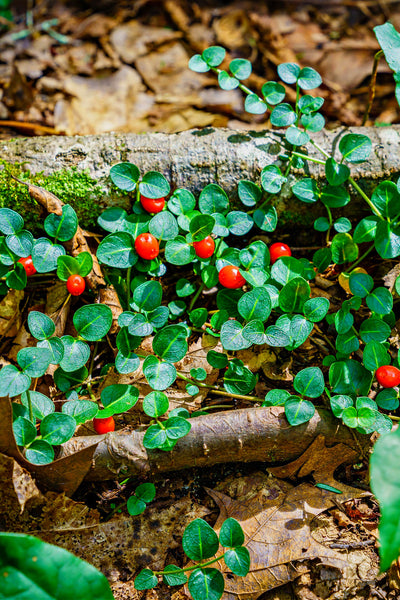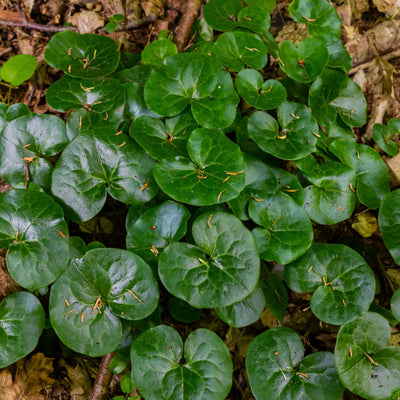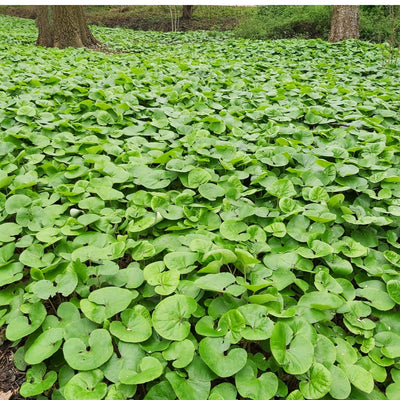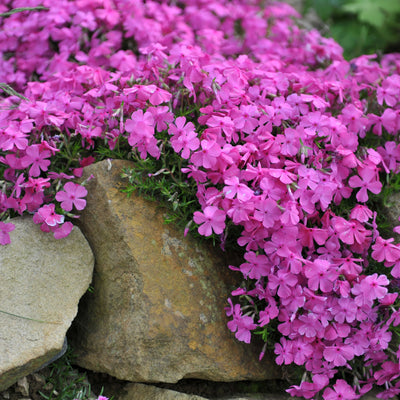This article is all about herbaceous perennial groundcovers. It answers the most common questions customers ask about groundcovers and how to use them. Plus, we include a list of seven Herbaceous Perennial groundcovers along with a few bonus plants. Keep reading to learn more about these useful garden plants.
What is a herbaceous perennial?
Herbaceous perennials are plants that grow vegetation, bloom, seed, and grow back the following year. Though the vegetation dies in winter, the plant will regrow from its roots the following spring and summer.
Annuals are plants that grow vegetation, flower, seed, and die off. Because annuals only last one grow season, they are not recommended for use as a groundcover.
What is a groundcover?
A groundcover is a plant that is low-growing and covers the ground. It may not be able to be seen readily from above. Its purpose is to, as its name implies, cover the ground. Groundcovers also help to prevent soil erosion.
A herbaceous perennial groundcover will return yearly and maintain its low-growing habit.
Why plant a groundcover?
Herbaceous perennial groundcovers are both functional and attractive.
Adding a herbaceous perennial groundcover to your garden can fill in empty patches giving your garden a fuller look. Groundcovers add beauty and can help elevate the overall appearance of your outdoor space.
Functionally, they serve as a means to limit erosion and improve soil health. They also act as a living mulch by keeping your soil moist and limiting the presence of weeds.
Where can I plant groundcovers?
- Under trees and shrubs to reduce mowing
- In empty patches in the garden
- As a lawn replacement
- Herbaceous perennial groundcovers can serve as a mulch alternative
- If you want to see them up close, plant them in containers and hanging baskets
- There are herbaceous perennial groundcovers that grow best in shade, sun, or somewhere in between
7 Herbaceous Perennial Groundcovers
Here is a list of herbaceous perennial groundcovers. Some are flowering, others are foliage plants. This list has a groundcover for every garden. Here is a list of seven herbaceous perennial groundcovers:
Ajuga Reptans
Ajuga reptans has lovely spikes of purple flowers when in bloom. It does well at filling bare patches while eliminating weed growth. Because it prefers full sun, it does best as an edging groundcover or in spaces where it won't be shaded out by other plants. This pollinator friendly groundcover can also make a great plant for hanging baskets.
Zones: 3 to 9
Sun exposure: Full sun
Mature height: up to 8 inches
Water: Average Best for front of borders, containers, and as a groundcover
Check out the Ajuga Reptans product page here
Vinca Minor
Vinca minor is a herbaceous perennial groundcover that has drifts of beautiful, purple flowers. It is a good spreader, so plant it in places you want to fill in quickly. It looks great in borders and can even be grown as a container plant. Additionally, vinca minor attracts pollinators and other beneficial insects.
Zones: 4 to 9
Sun exposure: Full sun
Mature height: up to 8 inches
Water: Average
Best for front of borders, containers, and as a groundcover
Check out the Vinca Minor product page here
Fan Clubmoss
This woodland plant thrives in shade. Fan clubmoss is a herbaceous perennial groundcover that can be planted under trees or shrubs. It looks great in woodland gardens and creates and creates a green carpet of texture wherever its planted. Fan clubmoss pairs well with ferns and can be planted in alpine gardens.
Zones: 4 to 9
Sun exposure: part sun to part shade
Mature height: up to 6 inches
Water: average
Best for woodlands, shaded gardens, alpine gardens, under trees or shrubs, and in containers
Check out the Fan Clubmoss product page here
Partridgeberry
The partridgeberry is an evergreen herbaceous perennial groundcover. It has dark, waxy green leaves that add a deep lush appearance to gardens. Because of its trailing vines, the partridgeberry can make an attractive spilling container plant. It also makes excellent decoration for winter when cut.
Zones: 3 to 9
Sun exposure: part sun to part shade
Mature height: up to 4 inches
Water: average Best for woodlands, shaded gardens, under trees or shrubs, and in containers
Check out the Partridgeberry product page here
Wintercreeper
Wintergreen is a herbaceous perennial groundcover that has ovate leaves. It can tolerate a wide range of soils and looks great in woodland gardens. Because it's a good spreader, it can cover a large, bare area quickly. Wintercreeper is low maintenance and reduces weed growth; a benefit to any gardener!
Zones: 3 to 9
Sun exposure: part sun to part shade
Mature height: up to 6 inches
Water: average
Best for woodlands, under trees or shrubs, and in containers
Check out the Wintercreeper product page here
European Ginger
The European ginger is a herbaceous perennial groundcover with lush waxy foliage. Despite its name, the European ginger is not edible. It grows in clumps and keeps the soil moist and weed-free. It's low maintenance and will provide season-long interest in your outdoor space
Zones: 4 to 8
Sun exposure: part shade to full shade
Mature height: up to 8 inches
Water: medium to wet
Best for woodlands, shaded gardens, under trees or shrubs, and in containers
Check out the European Ginger product page here
Wild Ginger
The wild ginger belongs to the same genus as the European ginger. Its lime green foliage grows in whorls across the ground. This plant does an exceptional job at carpeting bare pots in the garden. Aside from improving soil conditions, it gives a natural look to the garden-- what's not to love?
Zones: 4 to 8
Sun exposure: Full shade
Mature height: up to 6 inches
Water: average to we
tBest for woodlands, shaded gardens, under trees or shrubs, and in containers
Check out the Wild Ginger product page here
Ground Cover Mixed Pack (25 Plants)
If you can't decide on which groundcover you want, or if you like many of them, this option may be for you. Why settle on just one plant?
In this pack, Tennessee Nursery will send you 15 perennial groundcovers. This may include grasses, mosses, and other flowering perennials. Our horticultural specialist will cater the pack to match your USDA growing zone.
Check out the product page for the Ground Cover Mixed Pack (15 Plants) here
Bishop's Weed
While the bishop's weed is not technically a groundcover, it still has a lovely blanket habit like a groundcover. Its foliage grows to around 12 inches and when it blooms, the tall, thin flower stems poke up into the sky at 3 feet or less. It offers interest for most of the year, keeping the soil moist. Also, its striking variegated foliage is eye-catching and creates a sense of depth in the garden.
Zones: 4 to 9
Sun exposure: Sun or shade
Mature height: up to 3 feet
Water: average to wet
Best for woodlands edge, borders, and containers
We hope this list has given you some ideas for your garden. Many of these groundcovers can be divided in subsequent years, so few plants will go a long way in time. Having herbaceous perennials in the garden is cost and time effective. Not only does it reduce your time pulling weeds, but it adds fullness to beds and borders with little maintenance.
If you have any questions about herbaceous perennial groundcovers, or any other plants, please reach out to us! We love to talk about plants with anyone who is interested.

